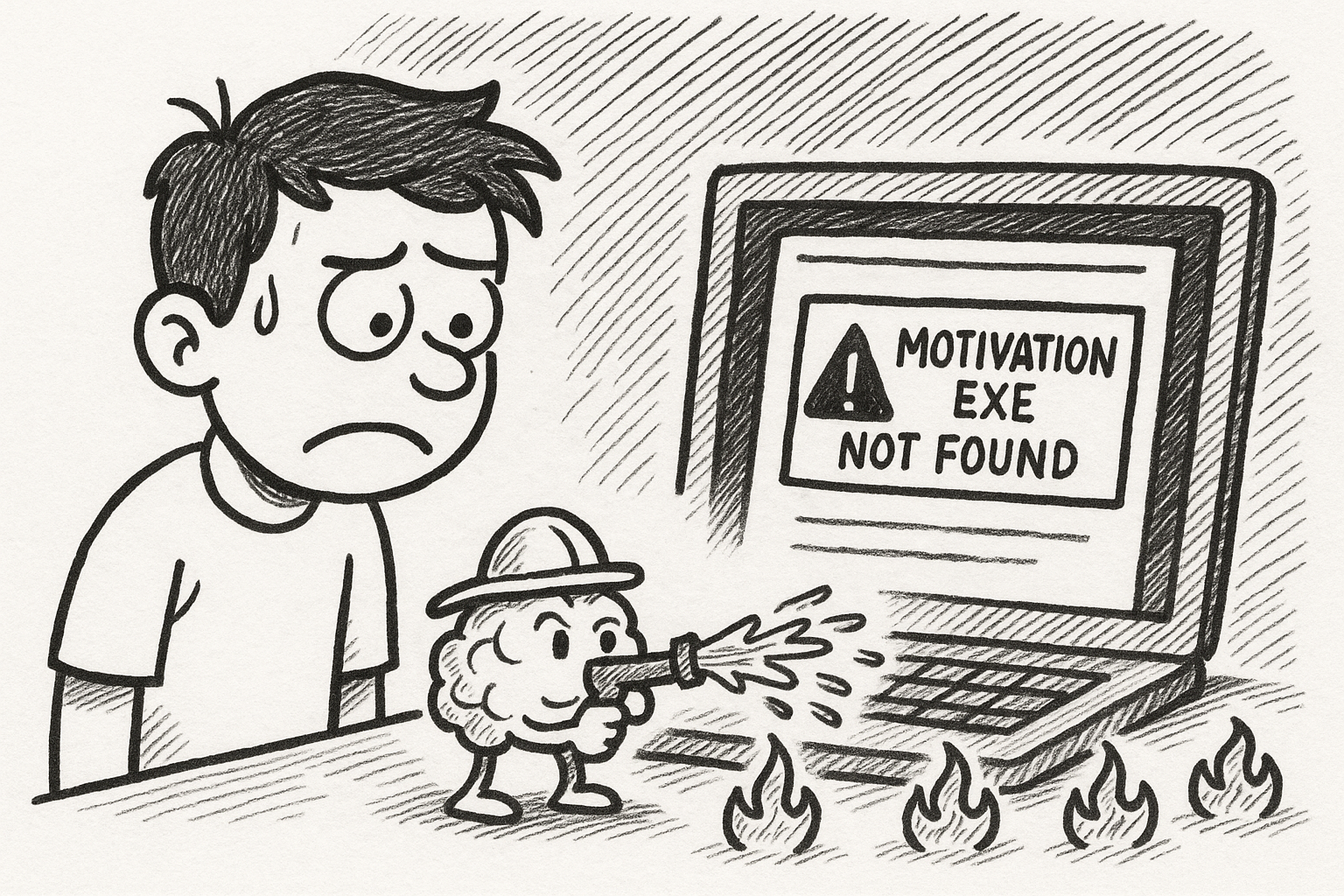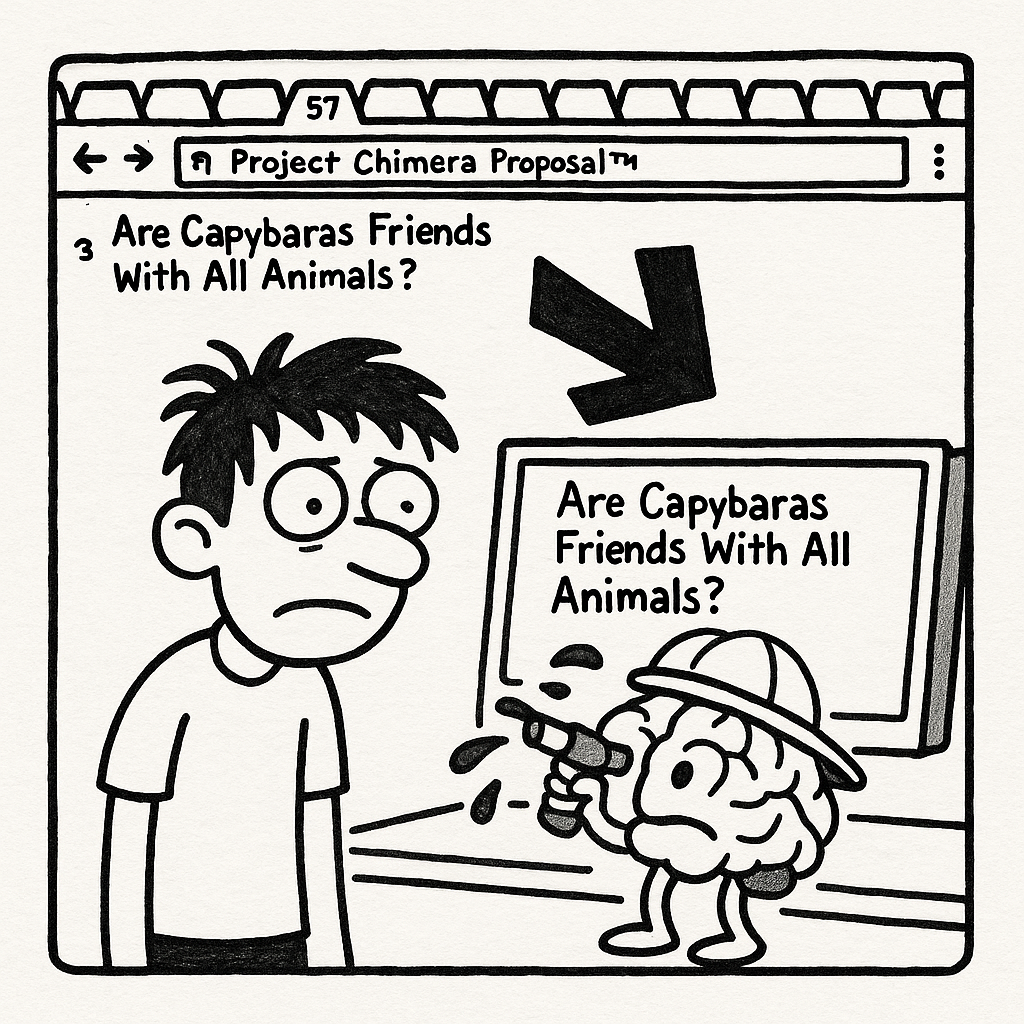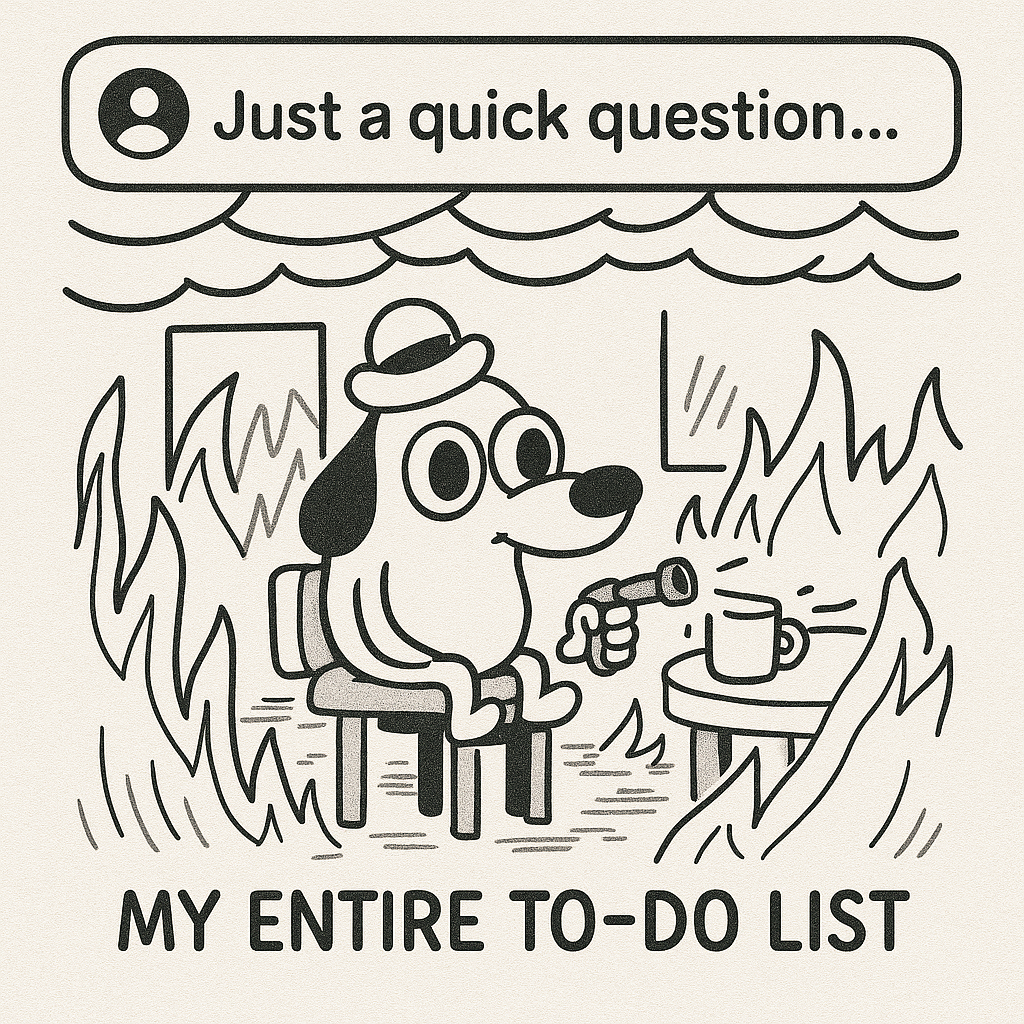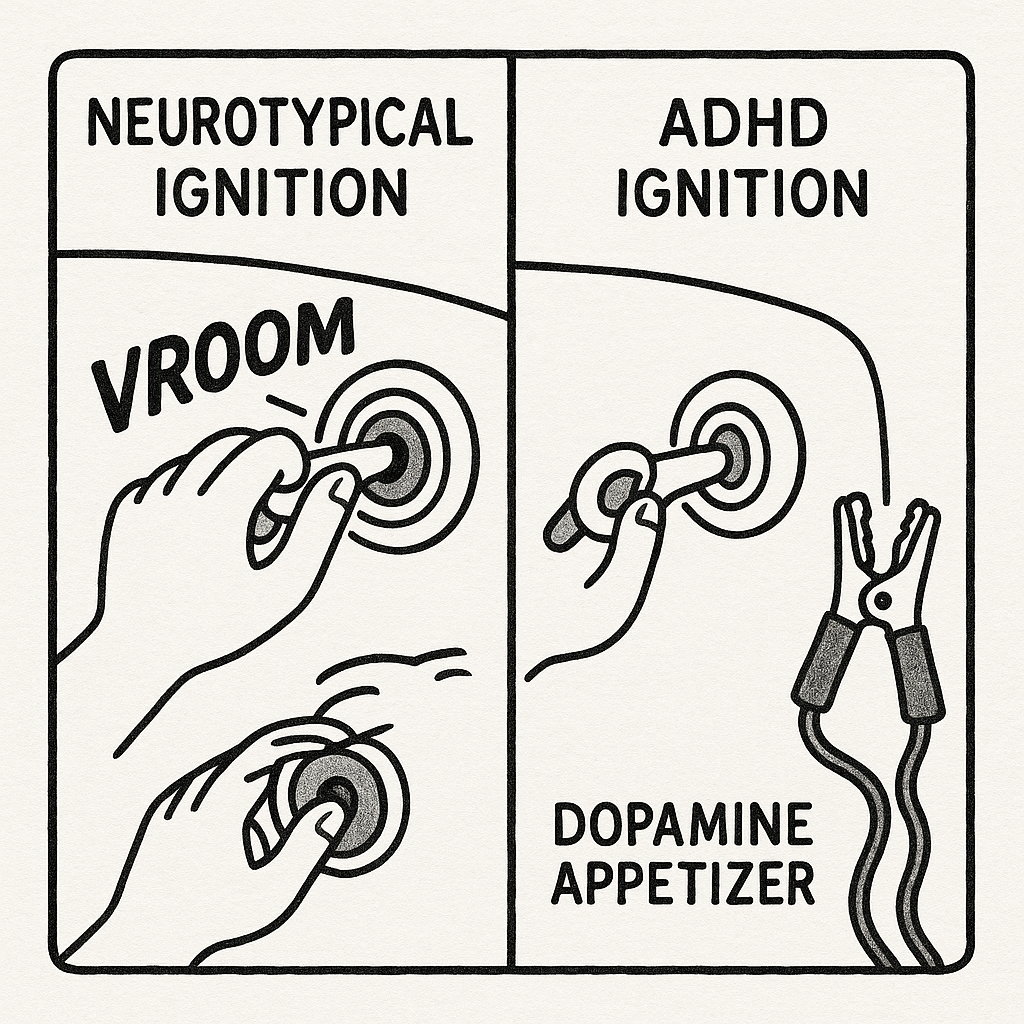Why Your ADHD Brain’s ‘Start Button’ Is Broken (And the 2-Minute Jump-Start)

📖 Take One
My name is Alex, and I am a Master of Priorities. This is an indisputable fact.
Which is why, when my manager, Bob, handed me the “Project Chimera Proposal”—a task that stared at me with the soul-crushing gravity of a black hole—my strategic brain immediately identified the real first step: I needed to curate the perfect, vibe-defining, lo-fi focus playlist. You don’t just write a proposal. You must first create an Aura of Genius, and that aura, it turns out, sounds like chill beats and requires a two-hour YouTube deep dive.
The proposal is due Friday. It’s Tuesday. Basically an eternity.
I open the blank document. The cursor blinks. Blink. Blink. It knows my secrets. I minimize it. Time to build the aura.
Ninety minutes later, my playlist is still not perfect, but I am now qualified to teach a college-level course on the history of the Roland TR-808 drum machine. Essential context, obviously. Just as I’m about to drag-and-drop another track, a Slack notification pops up.
Bob: Hey Alex, any chance I can get a sneak peek of that proposal today? Eager to see what you’ve got!
My heart does a little tap-dance of pure terror. I stare at the message, then calmly close the notification. He can’t rush genius. A true master like myself needs a pristine digital workspace. So, naturally, I spend the next hour meticulously organizing my desktop folders.
I look up at the clock. It’s 3:00 PM.
My internal defense attorney clears his throat. To recap: zero words written, but I am now a world-renowned expert on 80s Japanese synthesizers and my desktop is a work of art. The proposal continues to marinate in its own brilliance. Genius can’t be rushed. Also, I should probably eat lunch.

🔬 SCIENCE ALERT
🧠 Short Circuit: The Motivation Misfire
If you felt that story in your bones, here’s why. It’s not a character flaw. It’s a wiring issue. According to research from Dr. Nora Volkow and others, your ADHD brain has a profound “intention-to-action gap.” You have the intention, but due to dopamine dysregulation, your brain’s reward circuit doesn’t get a strong enough “future reward” signal from a big, important task.
Think of it like a car with a weak battery. Neurotypical advice says, “Just turn the key harder!” But that’s not the problem. Your brain needs a jump-start. Making matters worse, years of these misfires build what experts like Dr. Helyn Dolin call the “Wall of Awful”—an emotional barrier made of shame and fear of failure that makes starting feel emotionally impossible. You’re not just fighting a blank page; you’re fighting the ghosts of every blank page you’ve ever failed to fill.
The cheat code isn’t more willpower. It’s a dopamine appetizer.
🎮 SOLUTION QUEST
Forget “eating the frog.” We’re not eating anything gross. We’re giving the frog a little party hat and inviting it to a two-minute dance party.
Step 1: The One-Sentence Victory. Open the document. Write one, gloriously bad sentence. Example: “Project Chimera is a project that exists.” Done. You have broken the seal. +10 XP.
Step 2: The Task Appetizer. Before you touch the main task, do one unrelated, 2-minute task you can complete. Water the plant. Clear your actual, physical desk. Reply to one easy email. This gives your brain a tiny dopamine hit, making it easier to roll that momentum into the big thing. +20 XP.
Step 3: The Dopamine Sandwich™. This is the big one. Sandwich 15 minutes of the scary task between two 5-minute, genuinely fun activities. Watch a YouTube clip. Play one round of a phone game. Then work. Then another fun thing. You’re bribing your brain, and it works. +50 XP.

🔄Take Two
Okay. Wednesday. The ghost of yesterday’s productivity is mocking me from across the room. Today, there will be no “aura creation.” Today, we get tactical. I’m deploying a strategy I found online called the “Dopamine Sandwich,” which sounds like something you invent when you’re trying to trick a very stubborn toddler (the toddler being my brain).
The mission is simple: bribe the toddler. First, an offering. I sacrifice five precious minutes to the YouTube algorithm, watching a video of a guy building a tiny, functional kitchen for his hamster. The toddler is pleased.
Now, the trap is sprung. I set a timer for 15 minutes. The task: Project Chimera. My brain immediately files a formal complaint with management (me), stating that 15 minutes is an eternity and it would rather be Googling if hummingbirds can fly backwards (they can, I checked last week). I ignore the complaint and force my fingers to move. The sentences are clumsy, but they are undeniably words. The timer dings. Victory.
Phase three: the reward. Another five-minute video. A perfect plan. Except the YouTube algorithm is a cunning predator, and my willpower is a small, tasty woodland creature. It doesn’t stand a chance.
I snap back to reality. I check the clock—25 minutes have vanished. I brace myself for the familiar sting of self-loathing. I should feel shame. I do. But also… is that… a complete sentence on the page? More than one, actually. A whole paragraph.
Huh. My brilliant, foolproof plan was a chaotic mess. Except for the one part that actually, accidentally, worked. Weird.
![Cartoon Alex standing in a messy room, holding a tiny trophy that says ‘I Wrote A Paragraph.’ [cite_start]He’s giving a thumbs-up, but his expression is one of hopeful confusion. A thought bubble says, ‘Progress?’ with a wobbly question mark.](/images/why-cant-i-start-tasks-even-when-its-important.alex-progresses.png)
🌟 GLIMPSE OF THRIVE
Imagine a week where starting the big, important thing wasn’t a declaration of war against yourself. Imagine looking at your to-do list and feeling… curiosity instead of dread. That’s not a fantasy; it’s a different operating system.
Now pick one to try today →
- The 2-Minute Appetizer
- The One-Sentence Victory
- The Full Dopamine Sandwich
⚡ BONUS TIP
For the Overwhelmed (aka, if you skimmed right to the bottom):
If your brain is currently a browser with 50 tabs open and this article is tab #51, just do this: Pick ONE important task. Set a timer for 2 minutes. Work on it for just those 2 minutes. When the timer goes off, you have permission to stop. That’s it. You’ve won the day.

Comprehensive FAQ: Decoding the ADHD “Brain Freeze”
Category 1: Understanding the “Why”
Q: Why can’t I start tasks, even ones I know are important and actually want to do?
A: This is the core of ADHD task paralysis. It’s not a lack of desire; it’s a neurobiological issue with task initiation. Research, like that from Dr. Nora Volkow, shows the ADHD brain struggles with dopamine regulation. An important task with a distant reward doesn’t provide enough “get-started” dopamine, so your brain’s reward circuit fails to give the “go” signal, leaving you stuck in an “intention-to-action gap.”
Q: Is this just extreme procrastination, or is it different for ADHD?
A: It’s fundamentally different. While procrastination can be a behavioral choice to delay an unpleasant task, ADHD task paralysis is a “freeze” state rooted in executive dysfunction. As Dr. Russell Barkley’s work highlights, it’s an impairment in your brain’s self-regulation system. You aren’t choosing to delay; your brain is failing to launch the action sequence.
Q: What is the “Wall of Awful” and why does it make starting so hard?
A: The “Wall of Awful,” a concept described by experts like Dr. Helyn Dolin, is an invisible emotional barrier built from all the past negative experiences, shame, and fear associated with a task. When you face an important task, you’re not just facing the task itself; you’re facing the memory of every time you struggled before. This emotional wall, often amplified by Rejection Sensitive Dysphoria (RSD), can feel so intimidating that it triggers a freeze response.
Category 2: Practical Hacks & Strategies
Q: The “Dopamine Sandwich” sounds silly. Why does a “task appetizer” or reward actually work?
A: It works because it’s a neurochemical hack. Your brain won’t give you dopamine for the big, boring task, so you manually insert it. A “task appetizer” or the first part of a “Dopamine Sandwich” (like a fun video) provides an immediate dopamine hit. This gives your brain the chemical motivation it needs to overcome the activation energy and get started on the less-stimulating important task.
Q: What is the absolute smallest first step when I’m completely frozen?
A: The “One-Sentence Victory.” The goal isn’t to make progress; it’s to break the state of paralysis. Open the document and write one terrible, nonsensical sentence. Open the software and click one button. The physical action of starting, no matter how small, sends a signal to your brain that the “Wall of Awful” is not insurmountable.
Q: How do I explain this “start button” problem to my boss or partner without it sounding like an excuse?
A: Use a system-based analogy. For a boss: “I’ve found I’m most effective on big projects when I have a very clear, small first action item. It helps my brain get momentum. Could we define what that first ‘win’ should be?” For a partner: “My brain is like a car that needs a jump-start for big tasks. It’s not out of gas, the battery just needs a little jolt to get going. Helping me with that first tiny step is the best way to help.”
Category 3: Mindset & Troubleshooting
Q: I tried a hack but got distracted during the “reward” part and wasted an hour. Now I feel worse. What now?
A: This is a “Fail Forward” moment and it’s completely normal. The key is to reframe it. Did you write one paragraph before getting lost on YouTube for 30 minutes? That is a 100% improvement over writing zero paragraphs. The goal is not perfection; it’s messy progress. Acknowledge the partial win, forgive the distraction, and recognize you’re still ahead of where you were.
Q: How do I deal with the crushing guilt and self-blame when I’m paralyzed?
A: First, validate the feeling. It’s real and comes from years of feeling like you’re letting yourself down. Second, externalize the problem by labeling it with science. Say to yourself: “This isn’t me being lazy. This is my brain’s dopamine system misfiring.” By blaming the mechanism instead of your character, you reduce the emotional charge and can shift your focus to finding a practical workaround instead of spiraling into shame.
📢 CALL TO ACTION
- Screenshot your favorite hack from the “Solution Quest” and tag @QuirkyLabs on Instagram — we’ll DM you a bonus meme for your bravery.
- Did you try one step? Comment “Clutch hit” below. No essays needed. We’re celebrating tiny wins here.
